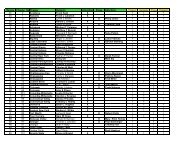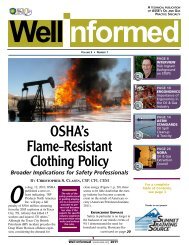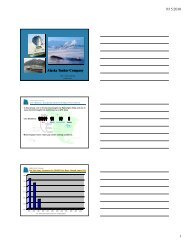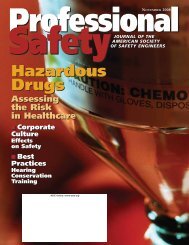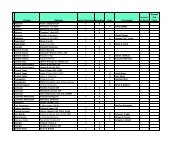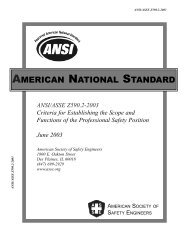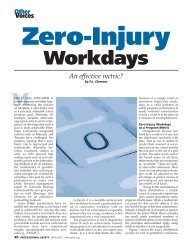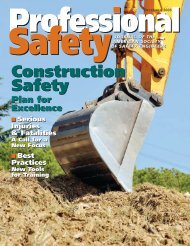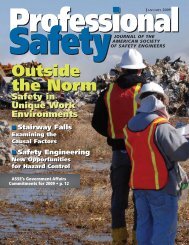Safety & Health Effects of Shift Work - ASSE Members
Safety & Health Effects of Shift Work - ASSE Members
Safety & Health Effects of Shift Work - ASSE Members
You also want an ePaper? Increase the reach of your titles
YUMPU automatically turns print PDFs into web optimized ePapers that Google loves.
RISK MANAGEMENT<br />
BY BRIAN EDWARDS, P.E. & P.H. HAROZ<br />
Keeping Hazards in the Box<br />
Minimizing the Risks <strong>of</strong> Combustible Dust<br />
It has been more than 3 years since OSHA issued<br />
the combustible dust national emphasis program<br />
(NEP). The NEP has been effective in at least one<br />
goal—to increase industry awareness <strong>of</strong> the hazards<br />
<strong>of</strong> combustible dust. However, dust fires and<br />
explosions continue to occur at an alarming rate. One<br />
possible reason for the continued occurrence <strong>of</strong> dust<br />
incidents is the lack <strong>of</strong> clear and concise rules by<br />
OSHA. The NEP provides background information on<br />
the hazards <strong>of</strong> combustible dust and gives inspection<br />
guidelines for compliance safety and health <strong>of</strong>ficers<br />
(CSHOs), but it does not clearly define what an employer<br />
must do to protect its employees and processes.<br />
This article provides an update on OSHA’s ongoing<br />
activities and discusses the major actions facilities can<br />
take to minimize the risks from combustible dust.<br />
Preventing the dangerous<br />
accumulation<br />
<strong>of</strong> dust inside<br />
facilities is <strong>of</strong>ten an<br />
endless, seemingly<br />
unwinnable battle.<br />
STATUS OF OSHA’S<br />
COMBUSTIBLE DUST RULEMAKING<br />
In late 2009, OSHA released an<br />
advanced notice <strong>of</strong> proposed rulemaking<br />
(ANPR), <strong>of</strong>ficially beginning<br />
the process to create a regulation<br />
specifically addressing combustible<br />
dust. The ANPR provided data about<br />
combustible dust and requested<br />
information from industry. However,<br />
it did not include any details on what<br />
OSHA plans to include in the rule.<br />
Since the ANPR was published, OSHA has held three<br />
stakeholder meetings on the topic <strong>of</strong> combustible dust.<br />
OSHA wanted to gather information from industry, labor<br />
and experts to be used in developing the proposed rule. In<br />
addition, OSHA held a web chat June 28, 2010, with the<br />
same goal. The most recent step taken by OSHA was an<br />
expert forum on combustible dust held May 13, 2011.<br />
The expert forum was held to discuss possible options<br />
for developing a comprehensive rule to address the hazards<br />
associated with combustible dust. OSHA’s stated<br />
intent was to both protect employees and be cost-effective<br />
for employers. It is impossible to predict exactly<br />
how OSHA will use the data, but a few main points<br />
made by the experts are summarized here:<br />
•The scope <strong>of</strong> the rule should cover all facilities that<br />
generate and handle combustible dusts.<br />
•The rule should make preventing hazardous levels <strong>of</strong><br />
fugitive dust accumulation a priority. This should be<br />
achieved by proper engineering and maintenance <strong>of</strong> equipment<br />
and dust collectors, safe housekeeping and training.<br />
•The rule should require some level <strong>of</strong> hazard/risk<br />
assessments.<br />
16<br />
Safely Made www.asse.org 2011<br />
Photo 1: Dust accumulating on overhead surfaces.<br />
•Some engineering controls should be required<br />
retroactively, but there should be some flexibility in how<br />
facilities decide what controls are required.<br />
•The rule must contain multiple types <strong>of</strong> controls,<br />
both administrative and engineering, to be effective in<br />
reducing the hazards associated with combustible dust.<br />
PREVENTING HAZARDOUS LEVELS<br />
OF FUGITIVE DUST ACCUMULATION<br />
A major discussion point during the OSHA expert<br />
forum was that the greatest hazards from combustible<br />
dust stem from the accumulation <strong>of</strong> fugitive dust in the<br />
work environment. By one expert’s account, more than<br />
90% <strong>of</strong> serious injuries and deaths associated with combustible<br />
dust occur from flash fires and explosions fueled<br />
by fugitive dust. Because <strong>of</strong> this, the OSHA rule is certain<br />
to focus on minimizing the amount <strong>of</strong> dust that<br />
accumulates on surfaces outside <strong>of</strong> process equipment.<br />
Already, OSHA has issued many citations for excess<br />
dust accumulation. According to OSHA’s Status Report<br />
on Combustible Dust National Emphasis Program, 20%<br />
<strong>of</strong> the citations issued under the NEP were for inadequate<br />
housekeeping.<br />
The most severe hazard associated with combustible<br />
dust comes from the threat <strong>of</strong> secondary explosions.<br />
Secondary explosions occur when a primary explosion,<br />
<strong>of</strong>ten inside process equipment or in an isolated area,<br />
sends pressure waves through a facility that dislodge fine<br />
dust that has accumulated on floors, walls and overhead<br />
surfaces. This fine dust then forms a cloud that spreads<br />
into a large area. If this dust cloud is ignited, a large,<br />
potentially devastating flash fire or explosion can occur.<br />
Preventing the dangerous accumulation <strong>of</strong> dust inside<br />
facilities is <strong>of</strong>ten an endless, seemingly unwinnable bat-




